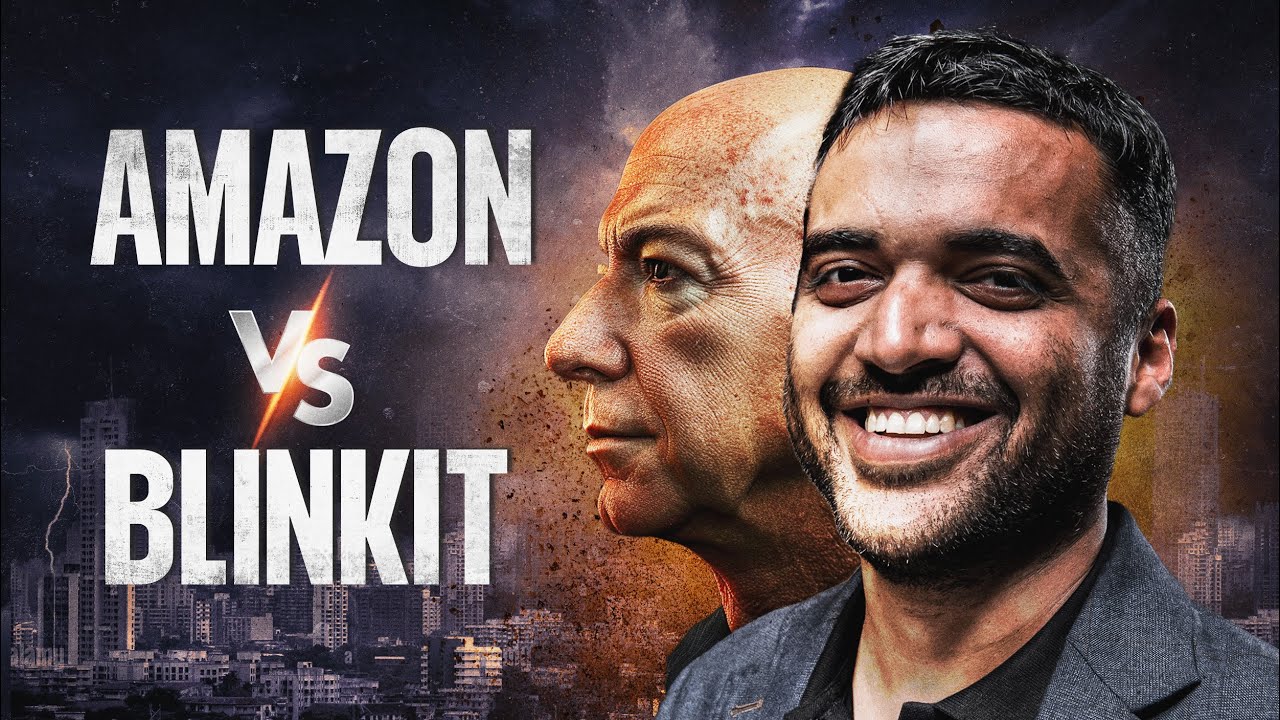THIS Is How Zepto & Blinkit Will Be Profitable | Explaining Quick Commerce
Summary
TLDRThe transcript discusses the rapid growth of quick commerce in India, with platforms like Blinkit and Zepto aiming to surpass traditional e-commerce giants. Quick commerce, which began as a COVID trend, has continued to thrive, threatening established players like Flipkart and Amazon. The business model revolves around 'dark stores' for rapid delivery, but profitability remains a challenge. Companies are tackling this by increasing order values, expanding store density, and leveraging advertising revenue. Zepto, with its strategic store placement and focus on operational efficiency, is positioned to lead the race towards profitability in the quick commerce sector.
Takeaways
- 🦈 Deepinder Goyal, founder of Zomato, predicts that its quick-commerce brand Blinkit will surpass Zomato in size within a year.
- 🚀 Aadit Palicha, the 22-year-old founder of Zepto, aims to scale the company to Dmart's level within the next 2 to 3 years.
- 🔥 Quick commerce, which started as a COVID fad, is proving to be a lasting trend, even threatening established giants like Flipkart and Amazon.
- 🌍 Quick commerce penetration in India is notably high, at 13% compared to 3% in Europe and 7% in China.
- 📈 Zepto has seen a significant increase in Monthly Active Users, growing from 1.8 million in 2022 to 4 million in 2023.
- 💰 Both Blinkit and Zepto have reached over 1 billion dollars in gross annual sales runrate.
- 🛒 Quick commerce platforms contribute significantly to e-commerce sales of FMCG companies, with some like KRBL witnessing a 1500% growth in sales on these platforms.
- 🏪 The business model of quick commerce revolves around 'dark stores'—small, employee-only stores located in convenient areas to enable fast delivery.
- 📦 Dark stores are stocked with around 1500 SKUs to meet most daily customer needs and are strategically placed to serve a 2 to 4 km radius.
- 🛵 Quick commerce delivery agents operate from these dark stores, ensuring fast delivery within minutes of an order being placed.
- 💼 Despite the rapid growth, quick commerce companies face profitability challenges due to high delivery costs and low margins on certain products.
Q & A
What is the current market share of Blinkit in the Quick Commerce segment?
-Blinkit currently has a market share of 35% in the Quick Commerce segment.
How has Zepto grown its Monthly Active Users from 2022 to 2023?
-Zepto has increased its Monthly Active Users from 1.8 Million in 2022 to 4 Million in 2023, adding 2.2 Million users in a single year.
What is the significance of the term 'dark stores' in the context of Quick Commerce?
-Dark stores are mini stores, roughly 3000 sq ft in size, accessible only to store employees, strategically placed to minimize the distance between them and customers for quick delivery.
Why are giants like Flipkart and Reliance interested in the Quick Commerce segment?
-Giants like Flipkart and Reliance are interested in Quick Commerce because it is a growing market that offers speed and convenience, threatening their traditional e-commerce models.
What is the average profit margin for groceries and FMCG products in Quick Commerce?
-Groceries have a higher profit margin of 18% to 40%, while FMCG products like oil or rice have a margin of 4% to 15%.
How do Quick Commerce platforms plan to increase their profitability?
-Quick Commerce platforms plan to increase profitability by increasing the Average Order Value, improving store density, and generating advertising revenue.
What is the role of Average Order Value (AOV) in the profitability of Quick Commerce companies?
-Increasing the Average Order Value can significantly improve profitability. For example, if the order value is increased from Rs. 300 to Rs. 700, the profit margin becomes Rs. 140, which is much higher than the initial profit.
How does store density impact the profitability and efficiency of Quick Commerce platforms?
-Higher store density, such as having more stores per city, can decrease delivery times and increase the number of deliveries per hour, which contributes to profitability.
What is the potential of advertising revenue for Quick Commerce platforms?
-Advertising revenue can be a significant source of income for Quick Commerce platforms, as they can charge companies to advertise on their apps, which results in almost pure profit.
How does Zepto's expansion strategy differ from its competitors?
-Zepto focuses on having a higher store density in fewer cities, which allows for faster delivery times and improved profitability compared to competitors with a broader but less dense presence.
What are the current market shares of the top Quick Commerce players in India?
-Blinkit leads with a 35% market share, followed by Swiggy’s Instamart with 28%, and Zepto with 25%.
Outlines

このセクションは有料ユーザー限定です。 アクセスするには、アップグレードをお願いします。
今すぐアップグレードMindmap

このセクションは有料ユーザー限定です。 アクセスするには、アップグレードをお願いします。
今すぐアップグレードKeywords

このセクションは有料ユーザー限定です。 アクセスするには、アップグレードをお願いします。
今すぐアップグレードHighlights

このセクションは有料ユーザー限定です。 アクセスするには、アップグレードをお願いします。
今すぐアップグレードTranscripts

このセクションは有料ユーザー限定です。 アクセスするには、アップグレードをお願いします。
今すぐアップグレード関連動画をさらに表示

Blinkit’s Genius Strategy that stunned Amazon and Flipkart | Business Case Study

Race To 10-Minute Delivery: Amazon Enters India’s $6-Billion Quick Commerce Market

Will Quick Commerce Be Profitable In India?

Quick Commerce Cashes In On Retail, But Scalability Remains An Issue | CNBC TV18

Quick Commerce Impact On Kirana Stores | FMCG Industry | Sandeep Ray

Can Reliance WIN the Quick Commerce War?
5.0 / 5 (0 votes)
